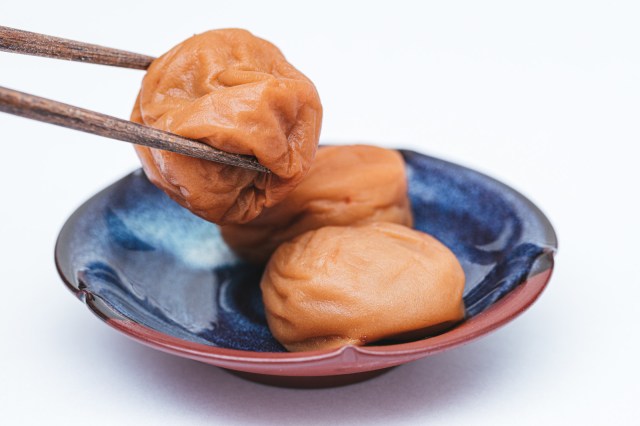
A traditional food is taking a hit among the younger generations in Japan.
Umeboshi (梅干し) is often translated as “pickled plum” in English but it more accurately describes the pickled version of a type of fruit called ume which is similar to an apricot. It’s often eaten on top of a bowl of rice or tucked away inside of an onigiri rice ball in Japan. With its high concentration of citric acid comes many health benefits, but also an extremely sour taste.
▼ Pucker up! A sample breakfast spread with two umeboshi waiting to be eaten
According to Sankei News, a daily Japanese newspaper largely focused on economic issues, the typical household expenditure for umeboshi among younger Japanese has decreased by roughly half since 1999. In general, a household budget survey by the Ministry of Internal Affairs and Communications indicated that yearly umeboshi expenditure per household (defined as two or more people) averaged 879 yen (US$8.11) in 1985, peaked at 1,897 yen in 1999, and while it rallied a bit in the last few years, has overall continued to decrease and dropped again to 1,474 yen last year.
When viewed in terms of different age brackets, last year those families with heads of household 70 years old and above spent over five times as much on umeboshi as those families with heads of household 29 years and below–2,012 yen versus 369 yen–resulting in the largest discrepancy in the past two decades. Furthermore, in 2000 the average umeboshi expenditure of families with heads of households 29 years and below was 694 yen versus the current 369 yen, indicating an almost 50 percent reduction.
Even Wakayama Prefecture, Japan’s top producer of ume which provides 65 percent of the nation’s crop, hasn’t escaped the declining trend. Last year’s household umeboshi expenditure in Wakayama averaged 3,168 yen–still overwhelmingly the highest expenditure in all of Japan, but nevertheless down from 2007 and 2009 when it exceeded 5,000 yen. From 2016 through last year the average expenditure has hovered around 3,000 yen.
▼ A typical reaction by younger Japanese and those unaccustomed to the sourness of umeboshi
So what accounts for the decrease in umeboshi consumption among younger Japanese? Dislike of its sour taste is generally attributed as being the main culprit. Sankei reporters interviewed some people outside of JR Wakayama Station in early March to hear their preferences for the pickled food. While the majority of younger voices expressed some form of distaste for the sourness, there were a few particularly strong reactions, including the following from a woman in her late 20s: “I hate it. I don’t like the texture, and it’s too sour. I ate it when I was little but I haven’t since then. My family likes it but I don’t.” Meanwhile, a 45-year-old man with a daughter in the second year of high school responded, “I like umeboshi and eat it every morning with breakfast. I feel something’s lacking if I don’t. However, my daughter doesn’t really eat it.”
Net voices also chimed in with their reactions to the data:
“I bought umeboshi yesterday. Ah, I guess I really can’t be called a ‘youth’ anymore.”
“But even just one umeboshi makes an excellent side dish at breakfast…”
“I see that today’s youth are closely monitoring their salt intake.”
“Even if you normally hate it you’ll want to eat it when you have morning sickness–trust me.”
“There are some sweeter varieties out there. Keep looking, young people!”
Bridging off that last comment, it seems that one possible strategy for cultivating an interest in umeboshi among the younger generations again is to increase production of sweeter varieties that are preserved with honey or brown sugar. Only time will tell if the household umeboshi expenditures rise again.
Source: Sankei News via Otakomu
Featured image: Pakutaso
Insert image: Pakutaso
● Want to hear about SoraNews24’s latest articles as soon as they’re published? Follow us on Facebook and Twitter!